Guide to electrical materials for all. Part 9
Continuing guidance on electrical materials. In this part, we still disassemble plastics: polytetrafluoroethylene, polyvinyl chloride, polyethylene terephthalate and silicones.
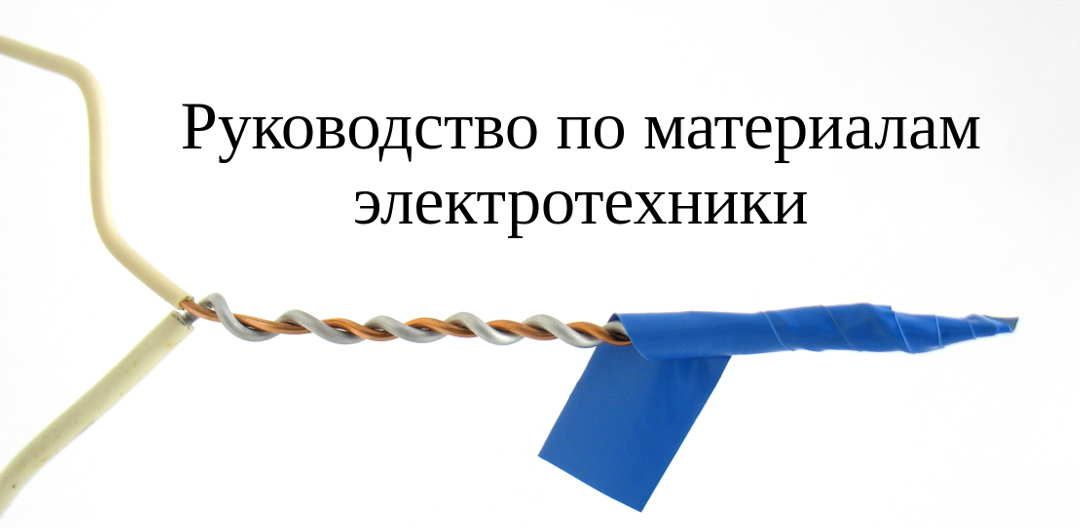
Welcome to CAT (TRAFFIC)
Unique in its properties plastic. Most often milky white slippery plastic.
Pure PTFE-4 soft - scratched with a fingernail.
"Glue for PTFE" is on the same shelf with the philosopher's stone, the holy grail
and other fantastic artifacts. PTFE is so chemically inert that
does not dissolve in anything, does not even swell. Gold even in aqua regia dissolves, and
PTFE do not give a shit about all these solvents. As a result - nothing is painted, nothing
not glued. (To be honest, there is a way to glue fluoroplast gluing, but it is clearly not for every workshop. It is described in more detail here .)
Fluoroplastic is a heat-resistant polymer that easily withstands temperatures of + 250 ° C. At temperatures above 415 ° C decomposes. In this case, by heating the fluoroplast, it can be softened, but it does not go into a plastic state, starting to decompose, therefore, products made of fluoroplastic are obtained by pressing a fine powder, followed by sintering.
In everyday life, you most often encounter fluoroplastics under the trademark “Teflon”, coating pans with a non-stick layer — this is all fluoroplast (or fluoropolymers with similar properties). (Due to the chemical inertness of PTFE, such pans are absolutely safe ... if they do not overheat. When overheated, the coating begins to deteriorate with the release of harmful substances. All other PFOA horror stories (PFOA - Perfluorooctanoic acid, perfluorooctanoic acid, caustic, toxic, sometimes used in the coating process Teflon, is destroyed during the subsequent annealing of products. The scandal was associated with the poisoning of the environment by the plant, which dumped PFOA into wastewater. Trace amounts of PFOA in the finished products do not cause any significant harm to health.) relevant to workers of production, and not consumers of products).
PTFE has a very low slip resistance, so PTFE-4 is good.
material for sliding bearings. But in its pure form, it shows a tendency to creep — it gradually flows under load, however, other fluoropolymers are deprived of this disadvantage.
Separately, I would like to mention the installation wire in PTFE insulation - MGTF (MGTF - Installation Flexible Heat-resistant insulation of PTFE.), White wire, which can often be found inside military equipment. It is easy to buy from us, it is cheap. If you search on ebay "teflon insulated wire", then it costs 3 times more expensive than the minimum. It is flexible, retains flexibility in a wide range of temperatures, and is not afraid of short-term overloads - the insulation does not drain. When soldering, the insulation does not “creep” from heating, which allows you to clean the tip of 0.5 mm and solder the chips in the TQFP (TQFP - Thin Quad Flat Pack, a type of chip package) to the package without any inconvenience. Unfortunately, due to the characteristics of the production of insulation (winding a thin film of fluoroplastic on the core), this wire is not suitable for work in a humid environment.
Tape FUM (Fluoroplastic Sealing Material) in plumbing for sealing threaded connections. Also used as a ball gasket in ball valves.
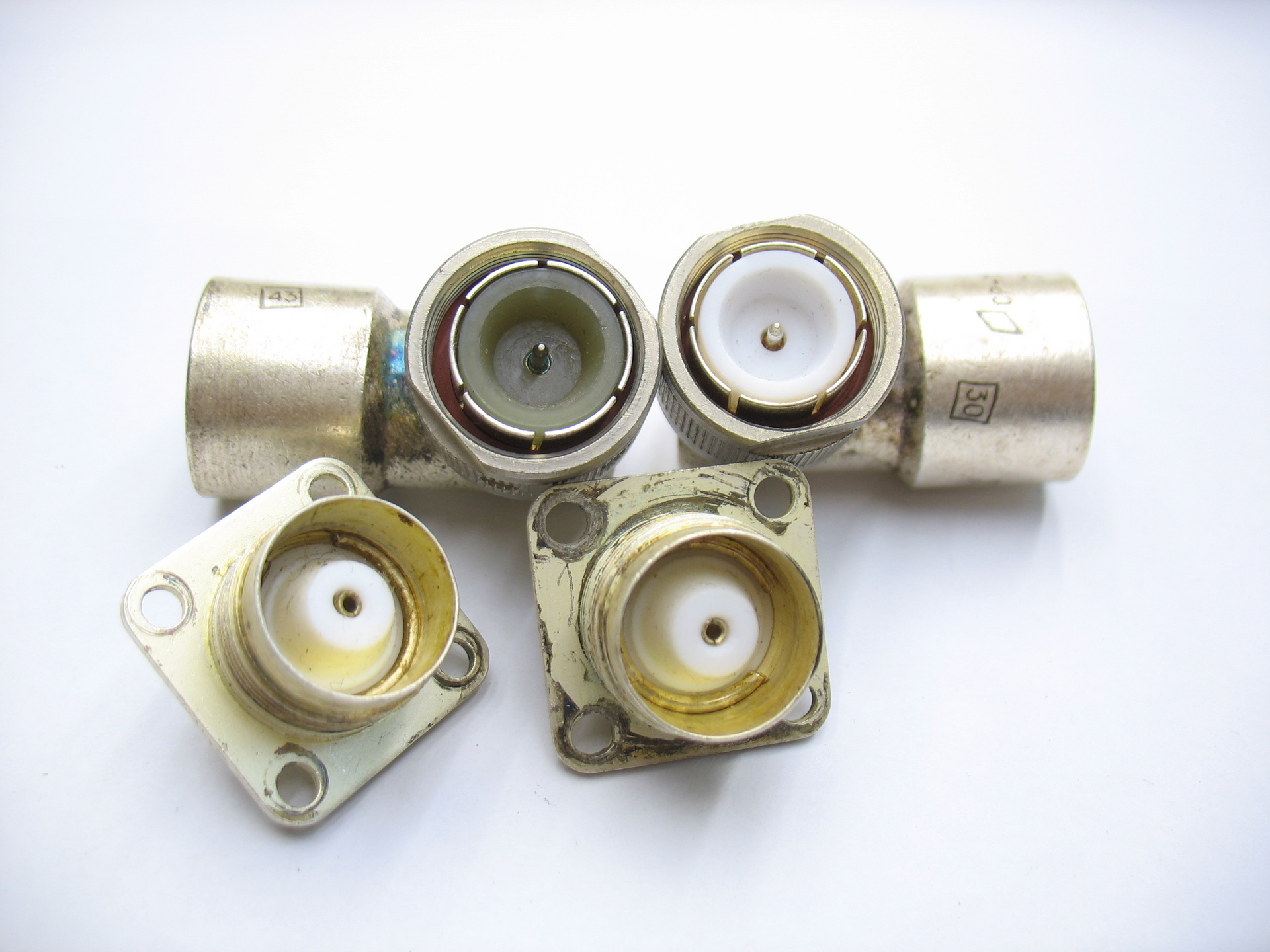
High Frequency Connectors. The insulator of the left is made of polyethylene, the right - of fluoroplastic. Connector housings are silver plated.
Dielectric in high-frequency connectors. Fluoroplastic keeps the central electrode of the connector, in contrast to polyethylene, you can not worry when soldering that the insulator will float from heating.
Insulation of heat-resistant wires. MGTF wire - installation wire in aviation devices.
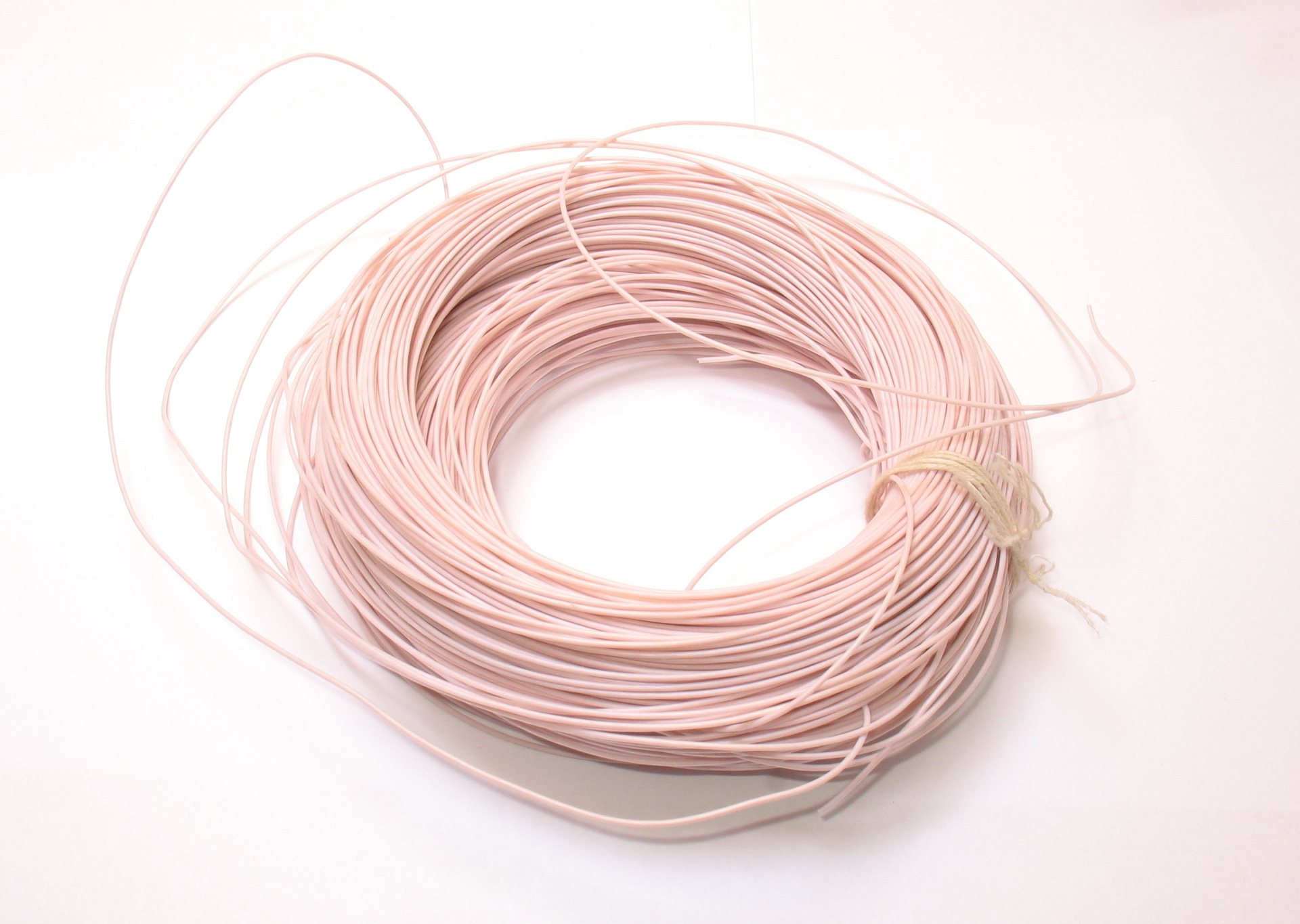
Coil of wire MGTF section of 0.35 mm2. The characteristic pinkish tint - copper shines through the fluoroplastic.
Fluoroplastic is sold by many companies in the form of rods, tubes (electrical insulating, therefore thin-walled), sheets. In fixing shops happens in the form of plugs, washers.
Fluoroplastic pneumatic tube is suitable not only as a tube for pneumatic devices in aggressive environments, but also as an insert into extruders of 3D printers, the heat resistance and slipperiness of the fluoroplastic there fits perfectly.
Fluoroplastic impregnated glass fiber - sold in hardware stores as a baking mat, looks like a thin sheet of yellowish cloth. (Not to be confused with a silicone mat that looks like thin rubber. About the writing on the box must be specified polytetrafluoroethylene (PTFE) or Teflon.) This material, for example, covers heaters for bag sealers - it is thanks to him that the film does not stick.
PVC itself is hard plastic, but with the introduction of a plasticizer it can be made flexible. Often in everyday life is used the name "Vinyl". Viniplast - the name of the material from PVC without plasticizer (hard). Available in the form of sheets, films.

Tee, corner, mounting brackets for corrugated channels, sealed cable entry - made of non plasticized PVC.
Insulation of wires - it is rather difficult to find a wire with non-PVC insulation in everyday life.
Insulating tape - the well-known blue electrical tape is PVC Gray corrugation for laying wires in construction - PVC. (black corrugation - polyethylene) Various inflatable toys - PVC.
Addition of antipyretic flammability is reduced to "does not support combustion, self-extinguishing . " (PVC itself without a plasticizer does not burn, combustibility arises due to a plasticizer, which is reduced by antipyretic agents.) Almost all general-purpose wires have PVC insulation.
Not bad glued , as special adhesives for PVC, and cyanoacrylate,
polyurethane. (Fistula in an inflatable toy made of PVC is well sealed with polyurethane
glue).
Not frost resistant. At -15 ° C, PVC headphone wires allow you to hold them horizontally to the ground. At -30 ° C, it is quite possible to break. For this reason, cable plants require before unwinding the coils with wires to allow them to rest in the warmth.
Not lightfast. PVC on the sun is destroyed, it becomes brittle. Therefore, polyethylene (black) corrugated channels are used outside, not PVC (gray)
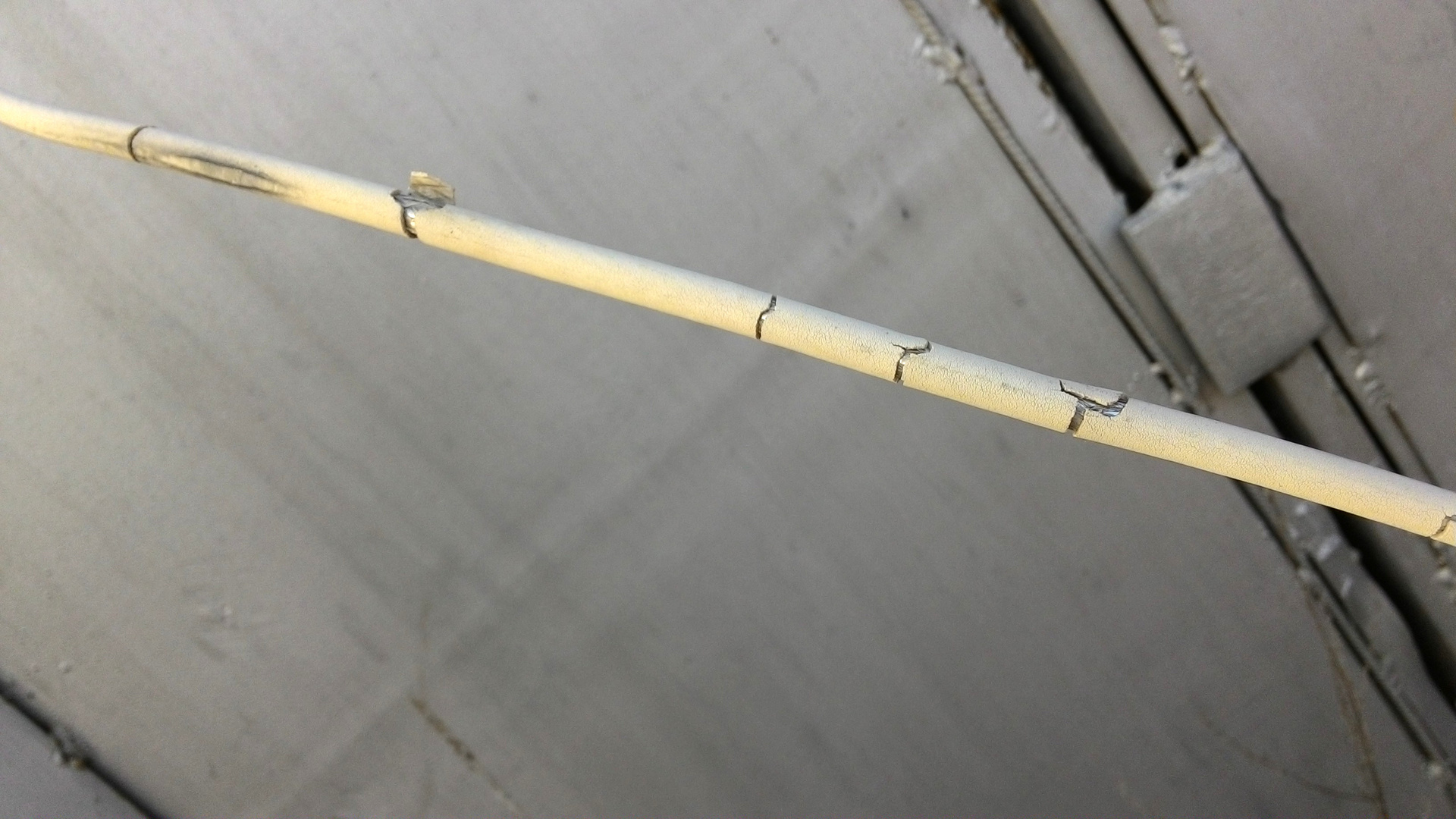
The sheath of coaxial cable with PVC insulation. Cable for internal wiring hung on the street for several years. The insulation has completely collapsed.
When heated, emits acrid toxic smoke containing including HCl. This smoke eats optics, so PVC is practically not cut on laser cutting machines. The use of PVC panels in the decoration dramatically increases the toxicity of smoke during a fire.
Plasticizer Migration. In plasticized (soft) PVC, the plasticizer does not enter into a strong chemical bond with the polymer; therefore, over time, the plasticizer can migrate and evaporate from the product, especially from the near-surface layers. Heating, contact with certain fuels, lubricants and solvents can accelerate this process. The result of this metamorphosis is the "tanning" of the product, the appearance of cracks. If long-term work of the product is planned and elasticity is required, then it is worth looking towards the elastomers. (Relatively recently, there was a scandal just connected with the release of a plasticizer from a cable. After some time, the cable began to weep with oil, but this was not a miracle, but a release of a plasticizer from the core of the cable. Googling for the key words “NYM cable was leaking”.)
Other names for this polymer are polyester, PET, Mylar (PET film is most commonly referred to as Mylar), polyester (LAVSAN-Laboratory of High Molecular Compounds of the Academy of Sciences) You encounter this polymer every day — bottles for water and beverages are obtained from it. Polyethylene terephthalate fiber is used to make fleece fabric. This is surprising, but a fleece sweatshirt and a bottle of soda are made from the same polymer. A rustling transparent packaging film, often mistakenly called cellophane, is PET.
PET is usually transparent (Transparent in amorphous and white in crystalline, the state depends on the cooling rate.) Plastic, comes in the form of sheets, preforms for the manufacture of bottles, in the form of a film.
It is easy to distinguish PET from polyethylene, polypropylene - the melting point of PET
about 250 ° C, so the soldering iron heated to 200 ° C should not cause the material to melt. However, even at a temperature of 100 ° C, PET can be quite deformed due to internal stresses without melting.
In addition to the applications described above, it is used as a dielectric in film boundaries.
densators. Mylar or polyethylene terephthalate capacitors are usually separate.
section of the catalog of radio components. There is a rather interesting old DuPont advertising film about mylar.

Foil film capacitor with polyethylene terephthalate film insulation.
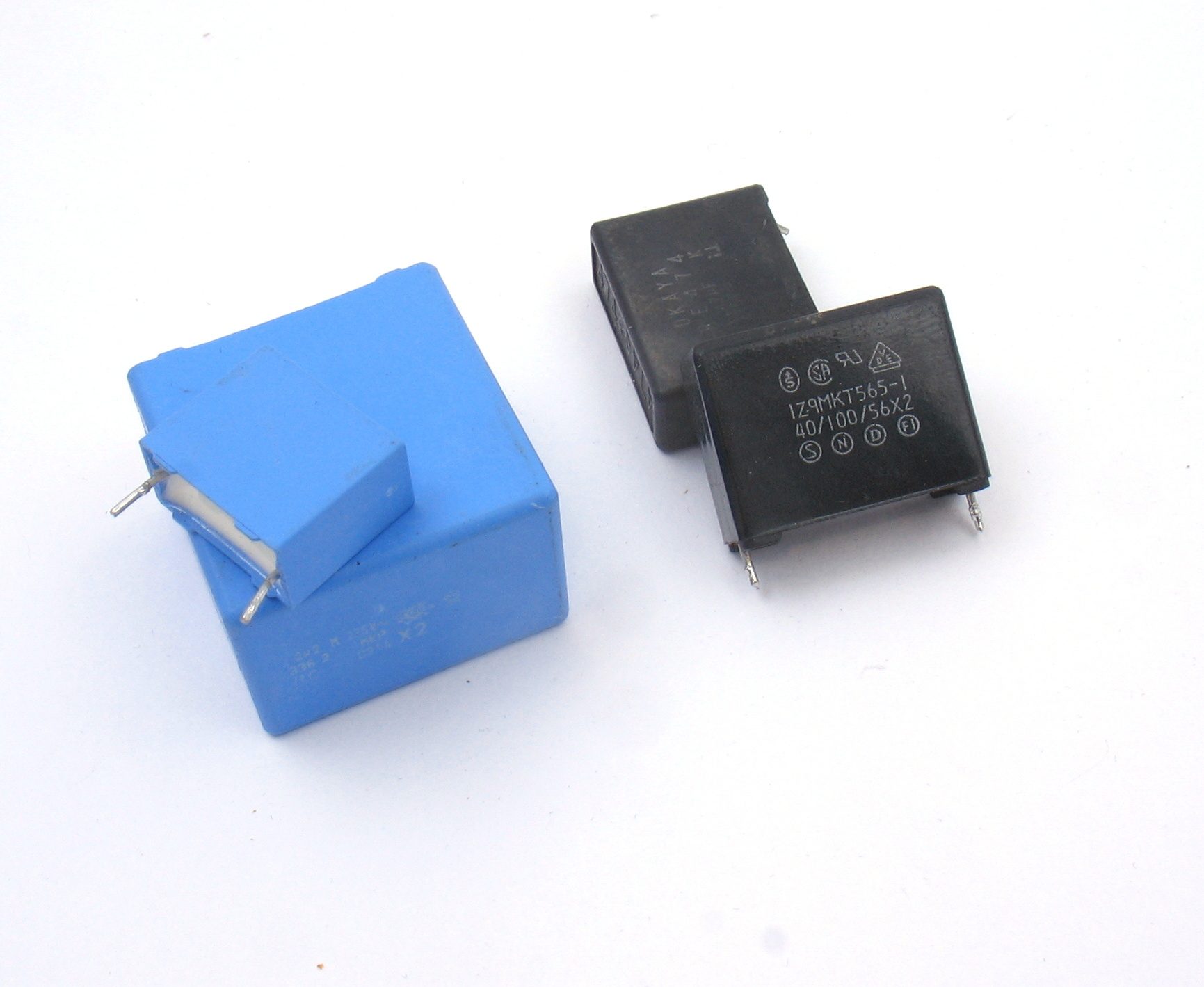
Film electric capacitors, on the left - polypropylene, on the right - polyethylene terephthalate. You can distinguish capacitors only by labeling.
Polyethylene terephthalate is sometimes used as a material for disposable printed circuit boards, for example, for RFID (Radio Frequency IDentification RFID). A RFID tag is a device that radiates a radio signal with information encoded in it when irradiated with radio waves. Store anti-theft tags are a special case of RFID tags.) tags.
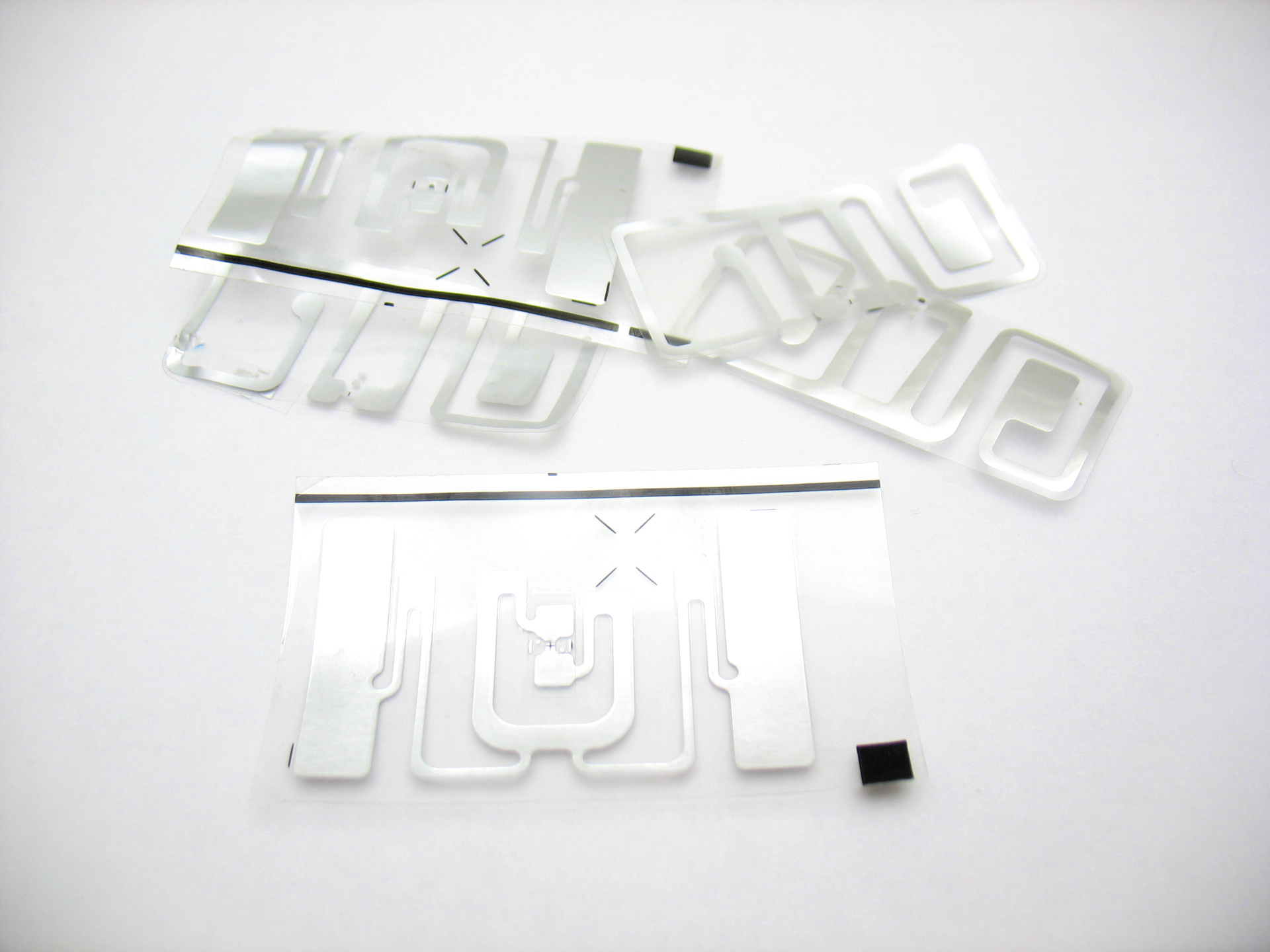
RFID tags, base material - polyethylene terephthalate, antenna conductors made in the form of aluminum plating. In the center - the chip.
Depending on the required thickness of the PET film can be obtained:
0,2-0,4 mm - walls of bottles from under water, soda
0.1 mm - film for printing on a laser printer (used for presentations
with an ordinary projector)
0,015 mm - culinary bags for baking
0,012 mm - with metallization - "rescue blanket" PET film with metallization
to reflect light and infrared rays, is included in the first aid kits.
0.125 - 0.08 mm - envelopes for lamination of documents, but have applied all over
surface adhesive layer.
Organosilicon compounds, of which the great variety. The basis of the polymer is
the skeleton of -Si-O-Si-O- atoms with different lateral tails of silicon, in contrast to
-CCCC- polyethylene / polypropylene skeleton, etc.
Managing the chemical composition and degree of polymerization in the production of silicones are obtained with different properties - from liquid lubricants and liquids, ending with elastomers and resins. Despite this, silicones have common properties.
Silicones are chemically inert. Not as much as polytetrafluoroethylene, but enough to make implants out of it, pour into household chemicals, add to food (For example, E900 food additive - Dimethylpolysiloxane, defoamer.). Baking tins, baking mats, various dishes are made from food grade silicone.
Low adhesion to many materials. The consequence of chemical inertness - practically nothing sticks to silicones. This is good if you cook in it, but bad if you need to glue the fallen off silicone leg from the laptop (From household glues, cyanoacrylate adheres to silicone (superglue, liquid, which instantly sticks fingers together), but it still holds poorly.) . Due to its chemical affinity, it adheres well to glass.
High temperature stability. Silicone elastomers remain flexible in freezing cold and do not melt at high temperatures. Some silicones can withstand temperatures of + 300 ° C.
Silicone rubber from other types of rubber can be distinguished if it is burned, silicone leaves white ash from silicon dioxide, ordinary rubber is black ash from carbon.
Insulation wires. As soon as PVC insulation raises doubts about its heat resistance, it is replaced with silicone. Wires in silicone insulation are used as terminals of powerful batteries with large peak currents, for connecting xenon lamps, halogen lamps. It so happened that in the post-Soviet space, if you need a heat-resistant thin installation wire, then it is easier to buy MGTF wire with fluoroplastic
insulation than with silicone. Power wires in silicone insulation are easier to buy,
than mounting.
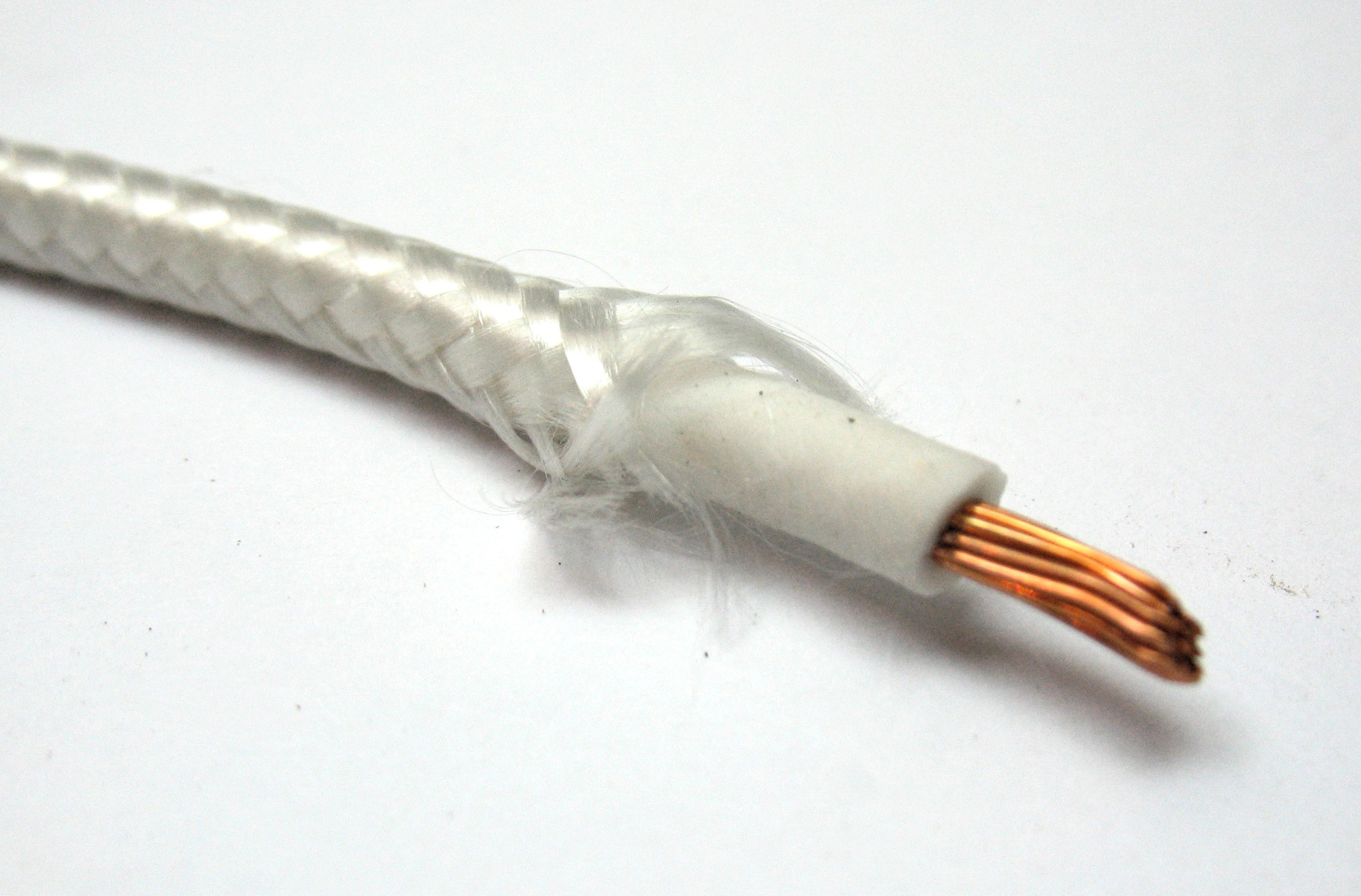
The wire RKGM 2.5 is a heat-resistant wire with insulation from silicone (silicone) rubber, stranded with fiberglass outer braid. Operating temperature -60 ° + 180 °
Elastic elements. Tubes, dampers, gaskets, seals, etc.
Silicone sealants, including heat-resistant - in hardware stores, in automotive stores. Silicone mat for baking - an excellent material for cutting gaskets, membranes. Two-component silicone casting compounds - suitable for casting silicone products, incl. food destination - in stores for creativity. Silicone tubes can be bought at homebrew shops.
1 : Conductors: Silver, Copper, Aluminum.
2 : Conductors: Iron, Gold, Nickel, Tungsten, Mercury.
3 : Conductors: Carbon, nichrome, thermostable alloys, solders, transparent conductors.
4 : Inorganic dielectrics: Porcelain, glass, mica, ceramics, asbestos, gas and water.
5 : Organic semi-synthetic dielectrics: Paper, click, paraffin, oil and wood.
6 : Synthetic dielectrics based on phenol-formaldehyde resins: carbolite (bakelite), getinax, textolite.
7 : Dielectrics: Glass fiber (FR-4), varnished cloth, rubber and ebonite.
8 : Plastics: polyethylene, polypropylene and polystyrene.
9 : Plastics: polytetrafluoroethylene, polyvinyl chloride, polyethylene terephthalate and silicones.
10 : Plastics: polyamides, polyimides, polymethyl methacrylate and polycarbonate. History of the use of plastics.
11 : Insulating tapes and tubes.
12 : Final

Welcome to CAT (TRAFFIC)
Fluoroplast-4 (PTFE polytetrafluoroethylene)
Unique in its properties plastic. Most often milky white slippery plastic.
Pure PTFE-4 soft - scratched with a fingernail.
"Glue for PTFE" is on the same shelf with the philosopher's stone, the holy grail
and other fantastic artifacts. PTFE is so chemically inert that
does not dissolve in anything, does not even swell. Gold even in aqua regia dissolves, and
PTFE do not give a shit about all these solvents. As a result - nothing is painted, nothing
not glued. (To be honest, there is a way to glue fluoroplast gluing, but it is clearly not for every workshop. It is described in more detail here .)
Fluoroplastic is a heat-resistant polymer that easily withstands temperatures of + 250 ° C. At temperatures above 415 ° C decomposes. In this case, by heating the fluoroplast, it can be softened, but it does not go into a plastic state, starting to decompose, therefore, products made of fluoroplastic are obtained by pressing a fine powder, followed by sintering.
In everyday life, you most often encounter fluoroplastics under the trademark “Teflon”, coating pans with a non-stick layer — this is all fluoroplast (or fluoropolymers with similar properties). (Due to the chemical inertness of PTFE, such pans are absolutely safe ... if they do not overheat. When overheated, the coating begins to deteriorate with the release of harmful substances. All other PFOA horror stories (PFOA - Perfluorooctanoic acid, perfluorooctanoic acid, caustic, toxic, sometimes used in the coating process Teflon, is destroyed during the subsequent annealing of products. The scandal was associated with the poisoning of the environment by the plant, which dumped PFOA into wastewater. Trace amounts of PFOA in the finished products do not cause any significant harm to health.) relevant to workers of production, and not consumers of products).
PTFE has a very low slip resistance, so PTFE-4 is good.
material for sliding bearings. But in its pure form, it shows a tendency to creep — it gradually flows under load, however, other fluoropolymers are deprived of this disadvantage.
Separately, I would like to mention the installation wire in PTFE insulation - MGTF (MGTF - Installation Flexible Heat-resistant insulation of PTFE.), White wire, which can often be found inside military equipment. It is easy to buy from us, it is cheap. If you search on ebay "teflon insulated wire", then it costs 3 times more expensive than the minimum. It is flexible, retains flexibility in a wide range of temperatures, and is not afraid of short-term overloads - the insulation does not drain. When soldering, the insulation does not “creep” from heating, which allows you to clean the tip of 0.5 mm and solder the chips in the TQFP (TQFP - Thin Quad Flat Pack, a type of chip package) to the package without any inconvenience. Unfortunately, due to the characteristics of the production of insulation (winding a thin film of fluoroplastic on the core), this wire is not suitable for work in a humid environment.
Portion of bile
Here is a post in a popular VC public with a video at 1:12, the whole essence of which was conveyed by the sentence above. I do not know what to call a trend, when instead of a paragraph of text and two pictures a video is recorded for ten minutes. I am just overwhelmed by indignation from the trend of yutubization of everything that the video hasn’t been filmed and no need to know.
Application examples
Tape FUM (Fluoroplastic Sealing Material) in plumbing for sealing threaded connections. Also used as a ball gasket in ball valves.

High Frequency Connectors. The insulator of the left is made of polyethylene, the right - of fluoroplastic. Connector housings are silver plated.
Dielectric in high-frequency connectors. Fluoroplastic keeps the central electrode of the connector, in contrast to polyethylene, you can not worry when soldering that the insulator will float from heating.
Insulation of heat-resistant wires. MGTF wire - installation wire in aviation devices.

Coil of wire MGTF section of 0.35 mm2. The characteristic pinkish tint - copper shines through the fluoroplastic.
Sources
Fluoroplastic is sold by many companies in the form of rods, tubes (electrical insulating, therefore thin-walled), sheets. In fixing shops happens in the form of plugs, washers.
Fluoroplastic pneumatic tube is suitable not only as a tube for pneumatic devices in aggressive environments, but also as an insert into extruders of 3D printers, the heat resistance and slipperiness of the fluoroplastic there fits perfectly.
Fluoroplastic impregnated glass fiber - sold in hardware stores as a baking mat, looks like a thin sheet of yellowish cloth. (Not to be confused with a silicone mat that looks like thin rubber. About the writing on the box must be specified polytetrafluoroethylene (PTFE) or Teflon.) This material, for example, covers heaters for bag sealers - it is thanks to him that the film does not stick.
Polyvinyl chloride - PVC
PVC itself is hard plastic, but with the introduction of a plasticizer it can be made flexible. Often in everyday life is used the name "Vinyl". Viniplast - the name of the material from PVC without plasticizer (hard). Available in the form of sheets, films.

Tee, corner, mounting brackets for corrugated channels, sealed cable entry - made of non plasticized PVC.
Application examples
Insulation of wires - it is rather difficult to find a wire with non-PVC insulation in everyday life.
Insulating tape - the well-known blue electrical tape is PVC Gray corrugation for laying wires in construction - PVC. (black corrugation - polyethylene) Various inflatable toys - PVC.
Buns
Addition of antipyretic flammability is reduced to "does not support combustion, self-extinguishing . " (PVC itself without a plasticizer does not burn, combustibility arises due to a plasticizer, which is reduced by antipyretic agents.) Almost all general-purpose wires have PVC insulation.
Not bad glued , as special adhesives for PVC, and cyanoacrylate,
polyurethane. (Fistula in an inflatable toy made of PVC is well sealed with polyurethane
glue).
Minuses
Not frost resistant. At -15 ° C, PVC headphone wires allow you to hold them horizontally to the ground. At -30 ° C, it is quite possible to break. For this reason, cable plants require before unwinding the coils with wires to allow them to rest in the warmth.
Not lightfast. PVC on the sun is destroyed, it becomes brittle. Therefore, polyethylene (black) corrugated channels are used outside, not PVC (gray)

The sheath of coaxial cable with PVC insulation. Cable for internal wiring hung on the street for several years. The insulation has completely collapsed.
When heated, emits acrid toxic smoke containing including HCl. This smoke eats optics, so PVC is practically not cut on laser cutting machines. The use of PVC panels in the decoration dramatically increases the toxicity of smoke during a fire.
Plasticizer Migration. In plasticized (soft) PVC, the plasticizer does not enter into a strong chemical bond with the polymer; therefore, over time, the plasticizer can migrate and evaporate from the product, especially from the near-surface layers. Heating, contact with certain fuels, lubricants and solvents can accelerate this process. The result of this metamorphosis is the "tanning" of the product, the appearance of cracks. If long-term work of the product is planned and elasticity is required, then it is worth looking towards the elastomers. (Relatively recently, there was a scandal just connected with the release of a plasticizer from a cable. After some time, the cable began to weep with oil, but this was not a miracle, but a release of a plasticizer from the core of the cable. Googling for the key words “NYM cable was leaking”.)
Polyethylene terephthalate (PET)
Other names for this polymer are polyester, PET, Mylar (PET film is most commonly referred to as Mylar), polyester (LAVSAN-Laboratory of High Molecular Compounds of the Academy of Sciences) You encounter this polymer every day — bottles for water and beverages are obtained from it. Polyethylene terephthalate fiber is used to make fleece fabric. This is surprising, but a fleece sweatshirt and a bottle of soda are made from the same polymer. A rustling transparent packaging film, often mistakenly called cellophane, is PET.
PET is usually transparent (Transparent in amorphous and white in crystalline, the state depends on the cooling rate.) Plastic, comes in the form of sheets, preforms for the manufacture of bottles, in the form of a film.
It is easy to distinguish PET from polyethylene, polypropylene - the melting point of PET
about 250 ° C, so the soldering iron heated to 200 ° C should not cause the material to melt. However, even at a temperature of 100 ° C, PET can be quite deformed due to internal stresses without melting.
Application examples
In addition to the applications described above, it is used as a dielectric in film boundaries.
densators. Mylar or polyethylene terephthalate capacitors are usually separate.
section of the catalog of radio components. There is a rather interesting old DuPont advertising film about mylar.

Foil film capacitor with polyethylene terephthalate film insulation.

Film electric capacitors, on the left - polypropylene, on the right - polyethylene terephthalate. You can distinguish capacitors only by labeling.
Polyethylene terephthalate is sometimes used as a material for disposable printed circuit boards, for example, for RFID (Radio Frequency IDentification RFID). A RFID tag is a device that radiates a radio signal with information encoded in it when irradiated with radio waves. Store anti-theft tags are a special case of RFID tags.) tags.

RFID tags, base material - polyethylene terephthalate, antenna conductors made in the form of aluminum plating. In the center - the chip.
Sources
Depending on the required thickness of the PET film can be obtained:
0,2-0,4 mm - walls of bottles from under water, soda
0.1 mm - film for printing on a laser printer (used for presentations
with an ordinary projector)
0,015 mm - culinary bags for baking
0,012 mm - with metallization - "rescue blanket" PET film with metallization
to reflect light and infrared rays, is included in the first aid kits.
0.125 - 0.08 mm - envelopes for lamination of documents, but have applied all over
surface adhesive layer.
Silicones
Organosilicon compounds, of which the great variety. The basis of the polymer is
the skeleton of -Si-O-Si-O- atoms with different lateral tails of silicon, in contrast to
-CCCC- polyethylene / polypropylene skeleton, etc.
Managing the chemical composition and degree of polymerization in the production of silicones are obtained with different properties - from liquid lubricants and liquids, ending with elastomers and resins. Despite this, silicones have common properties.
Silicones are chemically inert. Not as much as polytetrafluoroethylene, but enough to make implants out of it, pour into household chemicals, add to food (For example, E900 food additive - Dimethylpolysiloxane, defoamer.). Baking tins, baking mats, various dishes are made from food grade silicone.
Low adhesion to many materials. The consequence of chemical inertness - practically nothing sticks to silicones. This is good if you cook in it, but bad if you need to glue the fallen off silicone leg from the laptop (From household glues, cyanoacrylate adheres to silicone (superglue, liquid, which instantly sticks fingers together), but it still holds poorly.) . Due to its chemical affinity, it adheres well to glass.
High temperature stability. Silicone elastomers remain flexible in freezing cold and do not melt at high temperatures. Some silicones can withstand temperatures of + 300 ° C.
Silicone rubber from other types of rubber can be distinguished if it is burned, silicone leaves white ash from silicon dioxide, ordinary rubber is black ash from carbon.
Application examples
Insulation wires. As soon as PVC insulation raises doubts about its heat resistance, it is replaced with silicone. Wires in silicone insulation are used as terminals of powerful batteries with large peak currents, for connecting xenon lamps, halogen lamps. It so happened that in the post-Soviet space, if you need a heat-resistant thin installation wire, then it is easier to buy MGTF wire with fluoroplastic
insulation than with silicone. Power wires in silicone insulation are easier to buy,
than mounting.

The wire RKGM 2.5 is a heat-resistant wire with insulation from silicone (silicone) rubber, stranded with fiberglass outer braid. Operating temperature -60 ° + 180 °
Elastic elements. Tubes, dampers, gaskets, seals, etc.
Sources
Silicone sealants, including heat-resistant - in hardware stores, in automotive stores. Silicone mat for baking - an excellent material for cutting gaskets, membranes. Two-component silicone casting compounds - suitable for casting silicone products, incl. food destination - in stores for creativity. Silicone tubes can be bought at homebrew shops.
Links to parts of the manual:
1 : Conductors: Silver, Copper, Aluminum.
2 : Conductors: Iron, Gold, Nickel, Tungsten, Mercury.
3 : Conductors: Carbon, nichrome, thermostable alloys, solders, transparent conductors.
4 : Inorganic dielectrics: Porcelain, glass, mica, ceramics, asbestos, gas and water.
5 : Organic semi-synthetic dielectrics: Paper, click, paraffin, oil and wood.
6 : Synthetic dielectrics based on phenol-formaldehyde resins: carbolite (bakelite), getinax, textolite.
7 : Dielectrics: Glass fiber (FR-4), varnished cloth, rubber and ebonite.
8 : Plastics: polyethylene, polypropylene and polystyrene.
9 : Plastics: polytetrafluoroethylene, polyvinyl chloride, polyethylene terephthalate and silicones.
10 : Plastics: polyamides, polyimides, polymethyl methacrylate and polycarbonate. History of the use of plastics.
11 : Insulating tapes and tubes.
12 : Final
All Articles